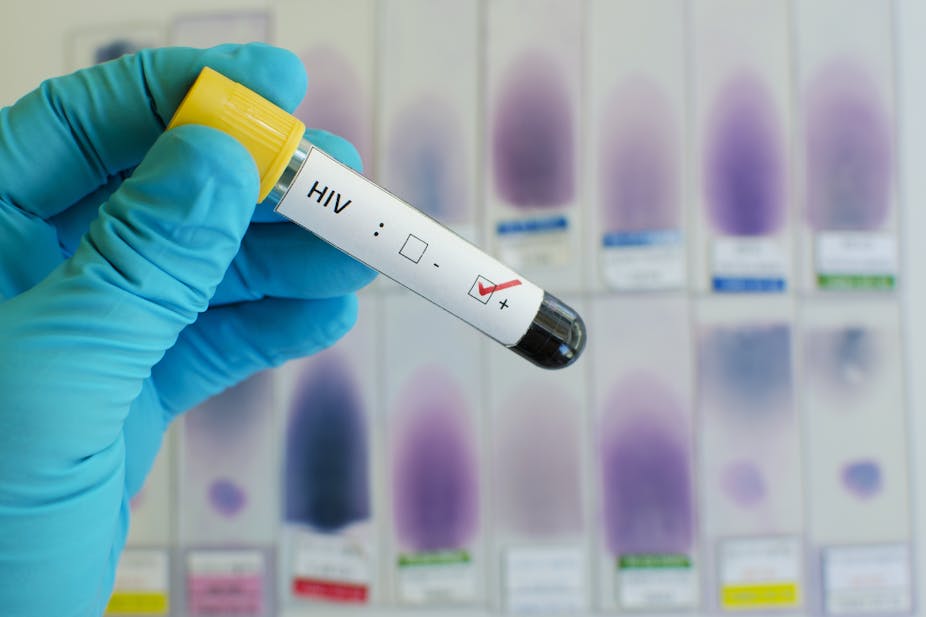Although great strides have been made at combating human immunodeficiency virus, leading to better quality of life and a longer life expectancy for those living with the virus, significant problems remain.
As of 2016, 36.7 million people worldwide were living with the virus. Of those people, 20.9 million accessed antiretroviral therapy, the lifesaving cocktail of drugs that slows the progression of the disease.
While this is an improvement from the previous year’s numbers, this still only covers about 57 percent of people infected.
My colleagues and I, in Michael Summers’ lab, work to determine the structures of HIV biomolecules in order to learn more about how those structures affect the function of the virus. We use this information to inform others seeking to design new HIV treatments.
As an AIDS basic researcher, I have experienced firsthand why lab work takes so long to reach actual AIDS patients.
High mutation rates complicate treatment

Treatment of HIV is complicated by a high mutation rate, which causes the virus to quickly develop resistance to antiretroviral therapies. This necessitates using a cocktail of drugs that each target a different step in the viral replication cycle, as it is less likely for the virus to simultaneously develop resistance to multiple drugs at the same time.
This combination of drugs initially resulted in large numbers of pills taken on a complex schedule, making it difficult for patients to keep track. Unfortunately for those with the virus, lack of adherence to the antiretroviral schedule increases the likelihood that the virus will develop resistance to the medications, which can complicate future treatment.
New therapies use combination pills that alleviate some of the strain associated with the treatment schedule, resulting in more patients adhering to their treatment regimen. Despite this, the World Health Organization estimates that only 74 percent remain in antiretroviral therapy after 12 months.
The WHO also found drug resistance in 10-22 percent of certain populations who had never received antiretroviral therapy, indicating that some people are initially infected with resistant strains of the virus. In order to combat this drug resistance, new classes of drugs focusing on different parts of the HIV replication cycle are needed.
The drug discovery process
Early development of antiretroviral drugs, such as AZT, used known compounds against the virus in the hopes of finding one with a therapeutic effect. This pathway to drug design requires screening thousands of drugs in an inefficient process.
To speed the process, researchers began developing rational drug design methods, which use computer modeling and information about the biological targets to create drugs aimed at stopping a specific viral process.
However, before this applied research can find new therapies, basic research must first identify and examine the potential targets. Basic research aims to expand the knowledge base or understand a phenomenon without immediate commercial applications. The exploratory nature of basic research makes it difficult to predict the outcomes, which often leads to unexpected results that redirect the path of the research. While exciting, these twists and turns often cause delays and require additional investigation, and can sometimes masquerade as mistakes.
Why HIV is different
Many people in our lab have worked to solve the structure of part of the HIV genome, which is composed of RNA instead of the DNA associated with most genomes. RNA has more flexibility than DNA, and thus has the ability to form unique structures.
The genome, or part of the virus that holds all the instructions to make a new virus, has two functions in an infected cell. As a single copy, or monomer, it codes for viral proteins that allow assembly of a new virus. However, the genome can also self-associate, making a two-copy structure called a dimer that is packaged into a new virus. There, it serves as the genetic blueprint for the virus in the next infected cell.
One of the major questions for early researchers was how the genome switches between the two conformations. The working hypothesis was than an equilibrium existed between the two states, allowing the genome to switch from one form to another. One of the graduate students in my lab, Sarah Monti, spent years working on the structure of the monomer, trying to find the conditions to stabilize the structure.
She used the genome sequence published in the HIV Sequence Compendium, a database of HIV sequences. When she went to recheck the sequence at a later point, she found that the sequence had changed slightly. At first fearing she had used the wrong sequence, she and another graduate student, Thao Tran, began digging into the matter further.
They found work from other labs that suggested that three different RNAs are made by the infected cell, each varying by a single building block at the beginning of the molecule. Sarah’s work with her collaborators found that these RNAs have different roles in the virus and are the root cause of the difference in function.
Further work with the genome has determined that the monomer and dimer molecules have unique structures that provide two targets for potential drugs. Disrupting either molecule could lead to a new class of therapeutics in the fight against HIV.
What was originally thought to be a mistake changed the way we think about RNA structures and rewrote the paradigm of how the HIV genome functions.
Unexpected results can lead to unexpected benefits
In my own work, a team and I sought to confirm a proposed mechanism about how the HIV virus assembles. Because we used a technique that limited the size of the molecules, we simplified the experiment by removing a part of molecule deemed unimportant for the process by other researchers.
Our experiments had results that differed from what the scientific literature suggested we should see. We repeated the experiments to ensure that we had completed them correctly. Then, we tried other experiments to probe the process further. After more than a year of exhausting other possible explanations, we concluded that the part we had removed was indeed important – a conclusion that has led to additional questions about the mechanism of the process.
Because scientific studies are published after careful consideration of the data and interpretation of the results, it’s difficult to know just how many breakthroughs started as experiments seeking something else.
Although basic research takes time and often does not go as intended, the same fundamental qualities that can lead to frustration can also provide unexpected rewards as well as the exhilaration of discovery. Basic science research of HIV often yields more results beyond the intended understanding of viral processes.

